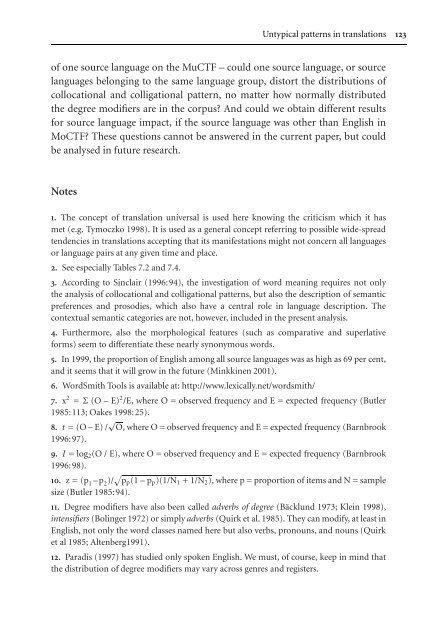Translation Universals.pdf - ymerleksi - home
Translation Universals.pdf - ymerleksi - home
Translation Universals.pdf - ymerleksi - home
You also want an ePaper? Increase the reach of your titles
YUMPU automatically turns print PDFs into web optimized ePapers that Google loves.
Untypical patterns in translations 123<br />
of one source language on the MuCTF – could one source language, or source<br />
languages belonging to the same language group, distort the distributions of<br />
collocational and colligational pattern, no matter how normally distributed<br />
the degree modifiers are in the corpus? And could we obtain different results<br />
for source language impact, if the source language was other than English in<br />
MoCTF? These questions cannot be answered in the current paper, but could<br />
be analysed in future research.<br />
Notes<br />
1. The concept of translation universal is used here knowing the criticism which it has<br />
met (e.g. Tymoczko 1998). It is used as a general concept referring to possible wide-spread<br />
tendencies in translations accepting that its manifestations might not concern all languages<br />
or language pairs at any given time and place.<br />
2. See especially Tables 7.2 and 7.4.<br />
3. According to Sinclair (1996:94), the investigation of word meaning requires not only<br />
the analysis of collocational and colligational patterns, but also the description of semantic<br />
preferences and prosodies, which also have a central role in language description. The<br />
contextual semantic categories are not, however, included in the present analysis.<br />
4. Furthermore, also the morphological features (such as comparative and superlative<br />
forms) seem to differentiate these nearly synonymous words.<br />
5. In 1999, the proportion of English among all source languages was as high as 69 per cent,<br />
and it seems that it will grow in the future (Minkkinen 2001).<br />
6. WordSmith Tools is available at: http://www.lexically.net/wordsmith/<br />
7. x 2 = Σ (O – E) 2 /E, where O = observed frequency and E = expected frequency (Butler<br />
1985:113; Oakes 1998:25).<br />
8. t =(O–E)/ √ O, where O = observed frequency and E = expected frequency (Barnbrook<br />
1996:97).<br />
9. I =log 2 (O / E), where O = observed frequency and E = expected frequency (Barnbrook<br />
1996:98).<br />
10. z=(p 1 –p 2 )/ √ p p (1 – p p )(1/N 1 + 1/N 2 ),wherep=proportionofitemsandN=sample<br />
size (Butler 1985:94).<br />
11. Degree modifiers have also been called adverbs of degree (Bäcklund 1973; Klein 1998),<br />
intensifiers (Bolinger 1972) or simply adverbs (Quirk et al. 1985). They can modify, at least in<br />
English, not only the word classes named here but also verbs, pronouns, and nouns (Quirk<br />
et al 1985; Altenberg1991).<br />
12. Paradis (1997) has studied only spoken English. We must, of course, keep in mind that<br />
the distribution of degree modifiers may vary across genres and registers.
















